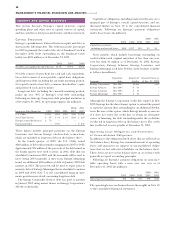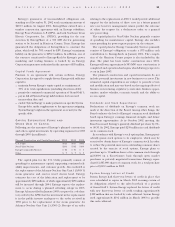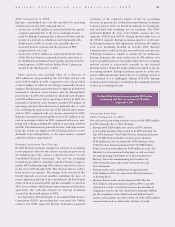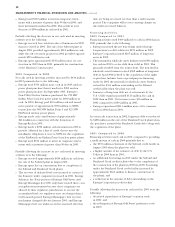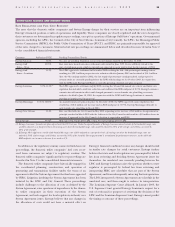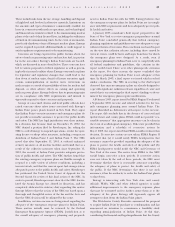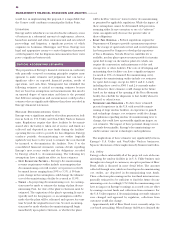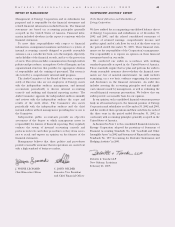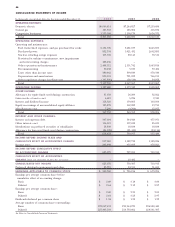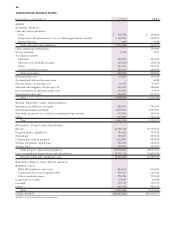Entergy 2002 Annual Report Download - page 39
Download and view the complete annual report
Please find page 39 of the 2002 Entergy annual report below. You can navigate through the pages in the report by either clicking on the pages listed below, or by using the keyword search tool below to find specific information within the annual report.
These include risks from the use, storage, handling and disposal
of high-level and low-level radioactive materials, limitations on
the amounts and types of insurance commercially available for
losses in connection with nuclear operations, and technological
and financial uncertainties related to decommissioning nuclear
plants at the end of their licensed lives, including the sufficiency
of funds in decommissioning trusts. In the event of an unantici-
pated early shutdown of any of Entergy’s nuclear plants, Entergy
may be required to provide additional funds or credit support to
satisfy regulatory requirements for decommissioning.
Concerns are being expressed in public forums about the
safety of nuclear generating units and nuclear fuel, in particu-
lar in the area where Entergy’s Indian Point units are located,
which are discussed in more detail below. These concerns have
led to various proposals to federal regulators as well as govern-
ing bodies in some localities where Entergy owns nuclear plants
for legislative and regulatory changes that could lead to the
shut down of nuclear units, denial of license extension appli-
cations, municipalization of nuclear units, restrictions on
nuclear units as a result of unavailability of sites for nuclear fuel
disposal, or other adverse effects on owning and operating
nuclear power plants. Entergy believes that its generating units
are in compliance with NRC requirements and intends to
vigorously respond to these concerns and proposals.
Groups of concerned citizens and local public officials have
raised concerns about safety issues associated with Entergy’s
Indian Point power plants located in New York. They argue
that Indian Point’s security measures and emergency plans do
not provide reasonable assurance to protect the public health
and safety. The NRC has legal jurisdiction over these matters.
In a decision that became final on December 13, 2002, the
NRC denied a petition filed by Riverkeeper, Inc. asking the
NRC to order Entergy to suspend operations, revoke the oper-
ating license or adopt other measures, including a temporary
shutdown of Indian Point 2 and Indian Point 3. The NRC
noted that after September 11, 2001, it ordered enhanced
security measures at all nuclear facilities and found that as a
result of the collective measures taken since September 11,
2001, the security at Indian Point provides adequate protec-
tion of public health and safety. The NRC further found that
the existing emergency response plans are flexible enough to
respond to a wide variety of adverse conditions, including a
terrorist attack, and that the current spent fuel storage system
adequately protects the public health and safety. Riverkeeper
has petitioned the United States Court of Appeals for the
Second Circuit for review of this final action of the NRC. In
order to prevail, Riverkeeper must show that the NRC has vio-
lated the Atomic Energy Act, abused its discretion, and has
completely abdicated its statutory duty regarding this matter.
Entergy believes that the action of the NRC was based upon a
thorough and thoughtful review of the law and the facts and
that the NRC decision will be affirmed by the court.
In addition, certain concerns are being raised regarding the
adequacy of the emergency response plans for Indian Point.
These matters initially must be reviewed by the Federal
Emergency Management Agency (FEMA). Jurisdiction as to
the overall adequacy of emergency planning and prepared-
ness for Indian Point lies with the NRC. Entergy believes that
the emergency response plans for Indian Point are in compli-
ance with NRC requirements and thus adequately protect pub-
lic health and safety.
A January 2003 consultant’s draft report prepared for the
State of New York to review emergency preparedness around
Indian Point concluded generically that federal emergency
planning regulations and guidelines were not adequate to cope
with new threats of terrorism. This conclusion was based in part
on the view that radiation releases, including those caused by
terrorist events, could be faster and larger than those for which
the emergency plans were designed. As a result, even if
emergency planning for Indian Point were to comply fully with
all federal regulations and guidelines, this criticism in the
report would stand. There were other plant-specific criticisms
in the report. For these reasons, the report concluded that
emergency planning for Indian Point is not adequate at this
time. In March 2003, a final report was issued which reached
similar conclusions. The NRC in reacting to the draft report
observed that current emergency plans are already designed to
cope with significant radiation releases regardless of cause and
stated that it was reviewing the draft report’s findings to deter-
mine if the emergency plans require modification.
A February 2003, report issued by FEMA Region II evaluated
a September 2002 exercise and related activities for the ten-
mile emergency planning zone around Indian Point. The
report identified no deficiencies with respect to the exercise.
The report did conclude that in the absence of corrected and
updated state and county plans, FEMA could not provide “rea-
sonable assurance” that appropriate measures can be taken in
the event of a radiological emergency. If the state provided this
information and a schedule of corrective actions by
May 2, 2003, the report stated that FEMA would reevaluate this
decision. If corrective actions are not taken, FEMA Region II
indicated that (a) it would notify FEMA headquarters that
assurance cannot be provided regarding the adequacy of the
plans to protect the health and safety of the public and (b)
FEMA headquarters would notify the NRC and Governor of
New York of the same. The notice from FEMA to the NRC
would begin corrective action periods. If corrective action
were not taken by the end of these periods, the NRC must
determine whether there is reasonable assurance regarding
the adequacy of plans to protect the health and safety of
the public. If the NRC determines that there is not such
assurance, it has the authority to order the Indian Point plants
to shut down.
Entergy is interacting with New York state and county
officials, FEMA, NRC and other federal agencies to make
additional improvements to the emergency response plans
that may be warranted and to further assure them as to the
adequacy of the plans. Entergy will vigorously oppose all
attempts to shut down the Indian Point plants.
The Westchester County Executive announced his proposal
to acquire Indian Point by purchase or condemnation and has
announced an intention to commission a feasibility study
regarding municipalization of Indian Point. At this time,
considering the financial and legal impediments that the County
ENTERGY CORPORATION AND SUBSIDIARIES 2002 37



